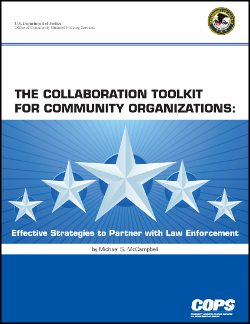
This toolkit is designed to help community organizations strengthen partnerships between the community and law enforcement agencies; further the community‘s role as a partner in crime-reduction efforts; identify and address social issues that diminish the quality of life and threaten public safety in communities; and link those in need to services and resources in the community.
An introductory section reviews the history of policing in America, with attention to the current model of community policing, problem solving, and collaboration with community organizations. This is followed by a section that focuses on the fundamentals of a community’s collaboration with its local law enforcement agency. It discusses the reason for collaboration, the nature of collaboration, and when collaboration between the community and police should occur. A third section outlines the first steps in establishing collaboration with a local law enforcement agency. Advice is given on how to approach the law enforcement agency about collaboration, the development of a partnership structure that combines the strengths of the community and the agency, and the development of a strategy for solving community problems in partnership. A fourth section addresses “building trust” between community representatives and the law enforcement agency. This is done by finding common ground, understanding and appreciating differing approaches, and action steps that can establish and build trust. The concluding section presents a step-by-step approach in the development of a successful collaboration. The steps outlined involve choosing a steering committee; community leadership in the development of the collaboration; the identification and leveraging of stakeholders; successful organization; the development of effective mission and vision statements; the collection of data that can help define community problems; the setting of realistic goals and objectives; evaluation of the collaboration; and ways to ensure the continuation of the collaboration.
